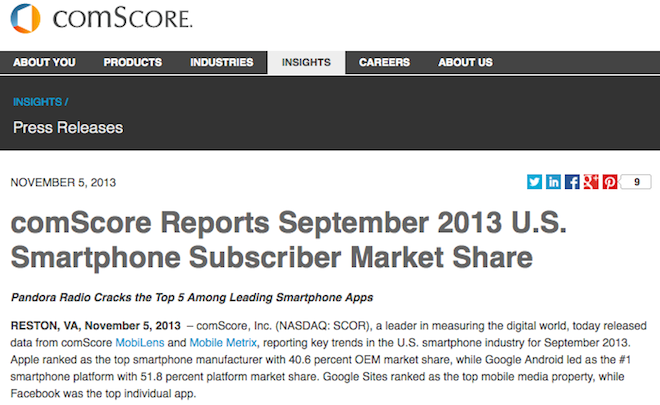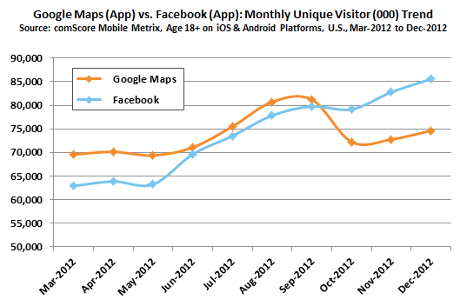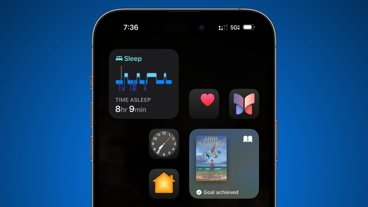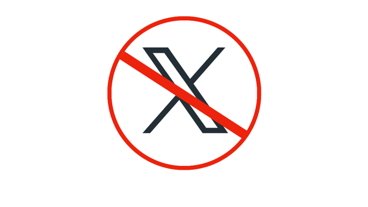Apple Maps took around 80 percent of Google Maps' iOS traffic in one year
Last updated
One year after the release of Apple's own iOS 6 mapping service, user data continues to show a precipitous decline in Google Maps among iOS users.
A report by Charles Arthur for The Guardian outlined new data from comScore, arriving at the same conclusion reached by AppleInsider last month:
The majority of iOS users are continuing to use Apple's Maps, while less than half of all smartphone users are using Google Maps. And despite the release of a competing, native Google Maps client app for iOS, it appears that most users are not actually seeking out alternatives, as the tech media has often assumed to be the case.The majority of iOS users are continuing to use Apple's Maps, while less than half of all smartphone users are using Google Maps
Even when including Google's own Android platform into the mix, Apple Maps has had a devastating impact on Google Maps. One year ago, Arthur stated, citing comScore data, 81.1 million were using Google for mapping out of a total population of 103.6 Android and iOS users.
The latest September data shows that just 58.7 million are still using Google's product, despite the total installed base having grown significantly to 136.7 million.
That's a shift from over 78 percent of all Android and iOS mobile users on Google Maps to just short of 43 percent in one year. On iOS, 35 million users pulled up Apple Maps in the month, out of a total population of 60.1 million users: more than 58 percent.
Arthur stated that iOS users accessing Google Maps fell from a peak of 35 million last September to around 6.3 million today, a decrease of more than 80 percent of Google's users.
Data from comScore indicates Apple's users interact with Maps more often (9.7 million iOS users access Maps each day, compared to just 7.2 million for Android) and spend more time in mapping apps: 75.5 minutes per month on average, compared to 56.2 on Android.
Another factor both map services face: younger people statistically make less use of mobile map apps. On top of that, comScore indicates that the release of iOS 6 last year effectively helped to erase six months of Google's user growth, despite incessant complaints about flaws in Apple's 1.0 release, some of which continue to persist one year later.
Apple is working to improve its maps product, having acquired a number of startups related to transit directions (including Locationary, HopStop, and Embark) and interior mapping with WiFiSLAM, dovetailing with the company's own iBeacons microlocation technology.
It has also worked to deliver 3D Flyover as a compelling visualization for both iOS mobile users and desktop Mac users, with the release Maps for OS X Mavericks and system-wide integration with Data Detectors.
Apple's Maps are also a strategic component of the company's plans for iOS in the Car, slated to begin rolling out on new cars in 2014. Apple's chief executive Tim Cook called the auto initiative a "key focus" for the company.
 Daniel Eran Dilger
Daniel Eran Dilger















 Amber Neely
Amber Neely
 Thomas Sibilly
Thomas Sibilly
 AppleInsider Staff
AppleInsider Staff
 William Gallagher
William Gallagher
 Malcolm Owen
Malcolm Owen
 Christine McKee
Christine McKee










223 Comments
Queue all the "Apple maps made me get lost" idiots
Queue all the "Apple maps made me get lost" idiots
Count me in that queue. Still have issues with nonexistent points of interest with Apple maps.
I'm not surprised by this result in the US market, but it would be interesting to know how it looks elsewhere. I am curious exactly how these data were derived though, and what the estimated error might be.
Lesson: Don't live in Afganastan
Sometimes the Air Force sends me to Afghanistan, but I have never tried to use Apple maps there.
Happy Veterans Day/Armistice Day.
I hope iOS In The Car is just the first step toward an iCar. At some point Apple should control the entire experience instead of putting lipstick on the pig of what the driving UI is—essentially unchanged since the days of Henry Ford.